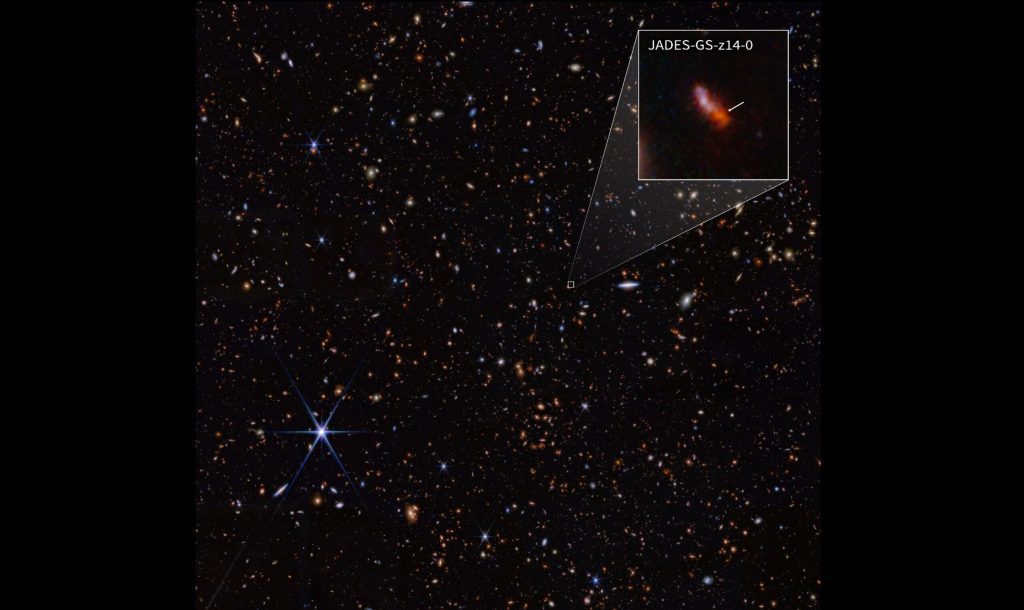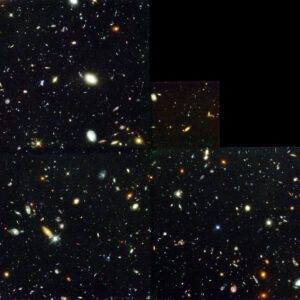The James Webb Space Telescope has broken its own record by observing two particularly distant galaxies. Its most distant history dates back to 290 million years after the Big Bang. This is the oldest and most distant galaxy observed to date.
In 2022, within a few weeks of the first observations, the James Webb Space Telescope has already broken the record for the oldest galaxy ever by nearly 100 million years. Then the telescope discovered the galaxy GLASS-z13, which existed only 300 million years after the Big Bang.
Now the space telescope is repeating that feat by capturing at least two galaxies from that early period of the universe. Write astronomers on preprint site Arxiv. It also turns out that one of these galaxies, called JADES-GS-z14-0, is the new record holder. This galaxy is the most distant and oldest ever observed. They date back to at least 290 million years after the Big Bang.
Read also
Chance has played a major role in many amazing cosmic discoveries
The universe is full of surprises. Astrophysicist Chris Lintott says: We have to accept serendipitous discoveries in science.
Looking back
Because the galaxy is billions of light-years away, it takes billions of years for light to reach a space telescope. So we see the system as it looked billions of years ago (290 million years after the Big Bang), when it was still very young. Astronomers don’t call them “oldest” because they look so ancient, but because they formed the longest ago of all known galaxies.
One of the space telescope’s main goals is to study the “cosmic dawn”: the first few hundred million years after the Big Bang. The first galaxies formed during this period. These galaxies can teach astronomers how gases, stars and black holes behaved in the early universe.
Young stars
The JADES-GS-z14-0 galaxy was first observed in early 2023. It was clear, then, that it dates back to the first few hundred million years after the Big Bang. But astronomers still have doubts about the exact age of the galaxy. The light emitted was remarkably bright for a galaxy so far away.
To get a better picture of JADES-GS-z14-0, researchers studied the light spectrum. Light is divided into different wavelengths, which correspond to different colors. Through the absence or presence of certain wavelengths, researchers were able to conclude that the galaxy already existed 290 million years after the Big Bang, that it is 1,600 light-years across, and that the bright light comes from young stars.

Oxygen
Furthermore, the light turned out to be redder than expected, and there are strong signs of oxygen in the system. That was surprising. This suggests that many massive stars had already lived in this very small galaxy, exploded, and spread their oxygen-containing “ash” across the galaxy.
“These observations tell us that JADES-GS-z14-0 does not resemble the types of galaxies that theoretical models and computer simulations suggest existed in the very early universe,” the astronomers wrote. Stefano Cargnani And Kevin Heinleinauthors of the article.
It therefore remains a mystery how such a system could have appeared so early. Researchers hope that the James Webb Space Telescope will help answer this question. Webb saw only a small portion of the sky. In the coming years, the telescope is likely to reveal much more about the cosmic dawn.

“Coffee buff. Twitter fanatic. Tv practitioner. Social media advocate. Pop culture ninja.”












More Stories
Which can cause an increase in nitrogen.
The Central State Real Estate Agency has no additional space to accommodate Ukrainians.
The oystercatcher, the “unlucky national bird,” is increasingly breeding on rooftops.